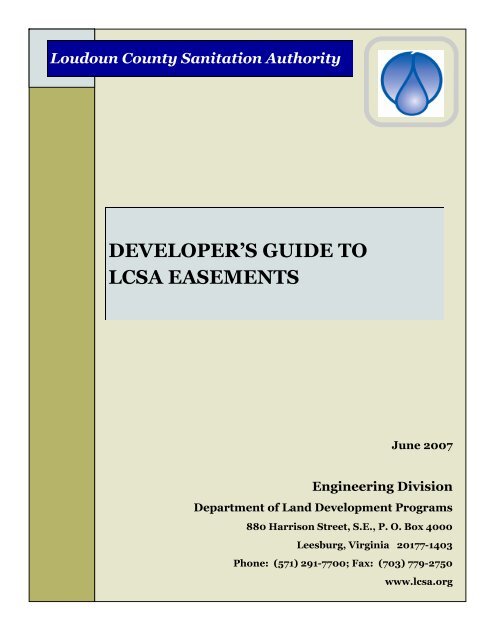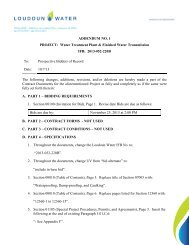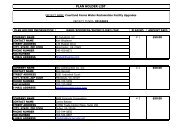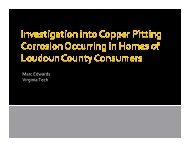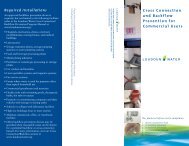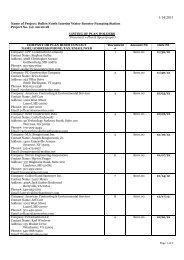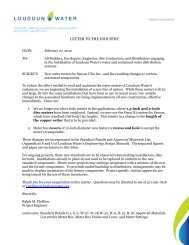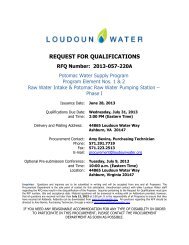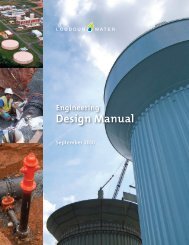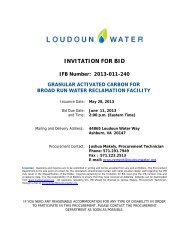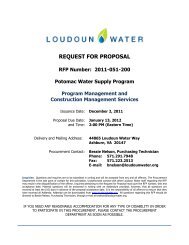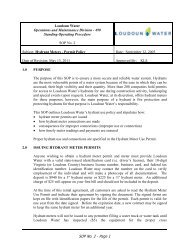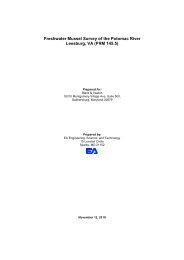Developer's Guide to Loudoun Water Easements
Developer's Guide to Loudoun Water Easements
Developer's Guide to Loudoun Water Easements
You also want an ePaper? Increase the reach of your titles
YUMPU automatically turns print PDFs into web optimized ePapers that Google loves.
<strong>Loudoun</strong> County Sanitation Authority<br />
DEVELOPER’S GUIDE TO<br />
LCSA EASEMENTS<br />
June 2007<br />
Engineering Division<br />
Department of Land Development Programs<br />
880 Harrison Street, S.E., P. O. Box 4000<br />
Leesburg, Virginia 20177-1403<br />
Phone: (571) 291-7700; Fax: (703) 779-2750<br />
www.lcsa.org
DEVELOPER’S GUIDE TO LCSA EASEMENTS<br />
The <strong>Loudoun</strong> County Sanitation Authority will experience two major<br />
changes in the near future.<br />
First, our operating name will be changing <strong>to</strong> “<strong>Loudoun</strong> <strong>Water</strong>”. This<br />
name will be used for day-<strong>to</strong>-day operations. However, our legal name<br />
will remain “<strong>Loudoun</strong> County Sanitation Authority”, and this name will<br />
continue <strong>to</strong> be used in all legal documents, such as easement deeds and<br />
plats. The new name will not affect easements in any way.<br />
The second change is our forthcoming move <strong>to</strong> our new office building<br />
at our Ashburn facility, which should occur around the first part of<br />
2008. At that time, our Leesburg office will be permanently closed.<br />
2
DEVELOPER’S GUIDE TO LCSA EASEMENTS<br />
Table of Contents<br />
I. Introduction 6<br />
II. Responsibility 6<br />
III. Easement Standards and Policies 6<br />
A. Standard Easement Widths 6<br />
B. Location of Pipe 7<br />
C. Exclusivity/Shared <strong>Easements</strong> 7<br />
D. Extensions of <strong>Easements</strong> 7<br />
E. Fire Hydrant <strong>Easements</strong> 7<br />
F. Meters and <strong>Water</strong> Service Lines 7<br />
1. Outdoor Meters 7<br />
2. Indoor Meters 7<br />
G. Fire Service Lines 8<br />
H. Blanket <strong>Easements</strong> 8<br />
I. Ownership v. <strong>Easements</strong> 8<br />
J. Private Streets 8<br />
K. Community System <strong>Water</strong> and Wastewater <strong>Easements</strong> 8<br />
IV. “LCSA Only” <strong>Easements</strong> 8<br />
A. Deed of Easement 8<br />
B. Notary Block 9<br />
C. Easement Plat Review Requirements 9<br />
D. Easement Review and Approval 9<br />
3
DEVELOPER’S GUIDE TO LCSA EASEMENTS<br />
E. Deed Execution 10<br />
F. Easement Recordation 10<br />
FLOW CHART: “LCSA Only” Easement Process 11<br />
V. LCSA/County of <strong>Loudoun</strong> Joint <strong>Easements</strong> (Signature Deeds) 12<br />
A. Review and Approval of Draft Deed and Plat 12<br />
B. Deed Language for LCSA <strong>Easements</strong> 12<br />
FLOW CHART: LCSA Signature Deed Process 13<br />
C. Notary Block 14<br />
D. Signature Deed Process 14<br />
1. Responsibility 14<br />
2. Signature Deed Package 14<br />
3. Final Review and Execution 14<br />
4
DEVELOPER’S GUIDE TO LCSA EASEMENTS<br />
Appendices<br />
1 Standard “LCSA Only” Easement Documents A.1-1<br />
1.1 Deed of Easement (<strong>Water</strong>) A.1-2<br />
1.2 Deed of Easement (Sewer) A.1-6<br />
1.3 Deed of Easement (<strong>Water</strong> and Sewer) A.1-10<br />
1.4 Deed of Easement and Vacation (<strong>Water</strong>) A.1-14<br />
1.5 Deed of Easement and Vacation (Sewer) A.1-19<br />
2 “LCSA Only” Easement Processing Request A.2-1<br />
3 LCSA Easement Plat Checklist A.3-1<br />
4 Joint <strong>Loudoun</strong> County/LCSA Deed Language A.4-1<br />
4.1 Standard Easement Paragraphs A.4-3<br />
5 Signature Deed Processing Request and Checklist A.5-1<br />
5
DEVELOPER’S GUIDE TO LCSA EASEMENTS<br />
I. INTRODUCTION<br />
Developers and/or individuals wishing <strong>to</strong> obtain public water and sanitary sewer<br />
service are responsible for construction of pipelines and appurtenances such as<br />
manholes, vaults, valves, and hydrants. The proposed construction plans must first<br />
be reviewed and approved by the Authority’s Department of Land Development<br />
Programs. Where not located within the rights-of-way of public streets, water and<br />
sanitary sewer facilities are constructed within easements dedicated <strong>to</strong> the Authority<br />
or on land owned by the Authority. The approval process may include easement<br />
acquisitions. The project plans and profiles must be approved and all necessary offsite<br />
LCSA easements must be recorded prior <strong>to</strong> issuance of a construction permit<br />
for the project. (Note: There are other requirements that must also be met prior<br />
<strong>to</strong> issuance of the construction permit. Please contact the Engineering Division’s<br />
Administrative Section for construction permit information.) Once constructed,<br />
ownership of the facilities is deeded <strong>to</strong> the LCSA.<br />
II.<br />
RESPONSIBILITY<br />
The Engineering Division’s Department of Land Development Programs is responsible<br />
for approving and processing all LCSA easements associated with land development<br />
projects.<br />
III.<br />
EASEMENT STANDARDS AND POLICIES<br />
A. Standard Easement Widths. <strong>Water</strong> and sanitary sewer easement widths<br />
shall be a minimum of:<br />
Condition<br />
Pipe<br />
Diameter<br />
Minimum<br />
Permanent<br />
Easement<br />
Width<br />
Minimum<br />
Temporary<br />
Construction<br />
Easement<br />
Width<br />
Within paved areas, including private<br />
streets<br />
Less than 20<br />
inches<br />
Traversing unpaved areas Less than 20<br />
inches<br />
All conditions for all pipes larger than 20<br />
inches in diameter<br />
20 inches or<br />
larger<br />
10 feet 10 feet<br />
15 feet 10 feet<br />
20 feet 15 feet<br />
6
DEVELOPER’S GUIDE TO LCSA EASEMENTS<br />
B. Location of Pipe. All pipes shall be centered within easements, except<br />
where space is reserved for future pipelines.<br />
C. Exclusivity/Shared <strong>Easements</strong>. All LCSA easements are exclusive.<br />
However, other utilities may cross LCSA easements at, or as nearly as<br />
possible, <strong>to</strong> a 90-degree angle. It is the Authority’s policy not <strong>to</strong> share<br />
easements with other entities due <strong>to</strong> the safety and liability issues and<br />
inconveniences that are inherent with such practice.<br />
Where overlapping of easements cannot be avoided, a License Agreement<br />
between the Authority and the owner of the other easement must be<br />
recorded in the Land Records of the Clerk of the Circuit Court prior <strong>to</strong> the<br />
start of any construction activities, including clearing and grading, within the<br />
easement.<br />
D. Extensions of <strong>Easements</strong>. Whenever future extensions of the mains are<br />
deemed practical by the Authority, an easement shall be extended <strong>to</strong> the<br />
boundary of the site or subdivision.<br />
E. Fire Hydrant <strong>Easements</strong>. All hydrants shall be placed within 10-footwide<br />
waterline easements.<br />
F. Meters and <strong>Water</strong> Service Lines. Meters and water service lines (from<br />
the water main <strong>to</strong> the meter) shall be placed within 10-foot-wide waterline<br />
easements and shall extend <strong>to</strong> 5 feet beyond the meter on all sides. Where<br />
meters are located outside the LCSA water main easement, each individual<br />
meter easement (minimum 10 feet x 10 feet) shall be shown on the easement<br />
plat and shall be labeled with dimensions. Should individual meter locations<br />
be adjusted or moved outside the boundaries of the easement during<br />
construction, a Deed of Vacation and Dedication, with accompanying<br />
easement plat, vacating the original meter easement(s) and dedicating new<br />
easement(s) at the as-built location(s) shall be prepared and recorded among<br />
the land records of the Clerk of the Circuit Court.<br />
1. Outdoor Meters. All water meters located outside the public righ<strong>to</strong>f-way<br />
or the boundaries of an LCSA waterline easement will be<br />
contained within minimum 10-foot by 10-foot LCSA waterline<br />
easements.<br />
2. Indoor Meters. No easement shall be placed on the service line nor<br />
on the meter.<br />
7
DEVELOPER’S GUIDE TO LCSA EASEMENTS<br />
G. Fire Service Lines. No easement shall be placed on a fire service line.<br />
H. Blanket <strong>Easements</strong>. The use of “blanket” easements allows for the<br />
relocation of facilities within the easement boundaries without having <strong>to</strong><br />
specify or show the actual locations of those facilities (e.g., meters and fire<br />
hydrants). I. Ownership vs. Easement. It is the preference of the<br />
Authority that major facilities such as pumping stations and water s<strong>to</strong>rage<br />
tanks be located on lots for which ownership has been deeded <strong>to</strong> the<br />
Authority. The minimum lot size required by the <strong>Loudoun</strong> County Zoning<br />
Ordinance for this purpose is one-half (0.5) acre.<br />
Perpetual easements in lieu of fee simple ownership must be specifically<br />
approved by the Authority prior <strong>to</strong> Utility Extension Request (UER) design<br />
review. The deed language <strong>to</strong> address the easement will be specified by<br />
LCSA at that time.<br />
J. Private Streets. LCSA facilities located within private streets must be<br />
contained within appropriate water and sanitary sewer easements dedicated<br />
<strong>to</strong> the Authority.<br />
K. Community System <strong>Water</strong> and Wastewater <strong>Easements</strong>. <strong>Easements</strong><br />
<strong>to</strong> serve community water and wastewater systems will be addressed in<br />
separate guidelines.<br />
IV.<br />
“LCSA ONLY” EASEMENTS<br />
For LCSA easements proposed as part of a project (i.e., no County easements are<br />
being dedicated on the site), the “LCSA Only” process will be followed.<br />
A. Deed of Easement<br />
Developers have the option of submitting Deeds of Easement prepared by<br />
their at<strong>to</strong>rneys or of completing the appropriate standard LCSA Deed of<br />
Easement (Appendix 1), which also are available on LCSA’s internet site—<br />
www.lcsa.org. Deeds prepared by at<strong>to</strong>rneys must include the standard<br />
LCSA deed language, which may not be altered.<br />
8
DEVELOPER’S GUIDE TO LCSA EASEMENTS<br />
B. Notary Block<br />
Effective July 1, 2007, the Commonwealth of Virginia notary public laws<br />
require notary blocks <strong>to</strong> be on the same page as the signature being notarized<br />
and that the notary’s registration number appear on each notarial statement.<br />
All notary seals shall be reproducible.<br />
C. Easement Plat Review Requirements<br />
The developer, or his representative, shall submit an Easement Plat Review<br />
Request package containing the following:<br />
1. A completed “LCSA Only” Easement Processing Request Form<br />
(Appendix 2).<br />
2. Draft Deed of Easement. The deed must be prepared either using the<br />
appropriate standard LCSA Deed of Easement or by the applicant’s<br />
legal counsel. Deeds prepared by legal counsel must contain all the<br />
Authority’s standard deed language, which may not be altered.<br />
3. One full-sized copy of the easement plat, prepared in accordance with<br />
LCSA’s Easement Plat Checklist (Appendix 3).<br />
4. Title Report for each property that is subject <strong>to</strong> the easement.<br />
D. Easement Review and Approval<br />
The easement plat and draft deed will be reviewed by the LCSA Project<br />
Engineer, who will advise the submitter of any revisions that may be<br />
required prior <strong>to</strong> plat or deed approval. Once approved, an approval letter<br />
will be sent <strong>to</strong> the submitter. The letter will advise the submitter that the<br />
Deed and plat have been approved and will advise the submitter <strong>to</strong> submit<br />
the original, executed Deed and a minimum of three (3) copies of the<br />
easement plat, showing the most recent revision date and with the surveyor’s<br />
seal and signature.<br />
9
DEVELOPER’S GUIDE TO LCSA EASEMENTS<br />
E. Deed Execution<br />
Prior <strong>to</strong> recordation all Deeds of Easement must be signed by:<br />
1. Owner(s) of Title. Owners of title include all parties who have an<br />
ownership interest in the property. In some situations, such as property<br />
titled in the name of an estate or the owner has provided power of<br />
at<strong>to</strong>rney <strong>to</strong> another individual, someone other than the property<br />
owner may sign the deed. However, in those cases, copies of the legal<br />
documentation that authorize such signature must be submitted <strong>to</strong><br />
LCSA with the easement package.<br />
2. LCSA. All Deeds of Easement must be signed by the General Manager<br />
or Deputy General Manager, particularly where vacations of previously<br />
recorded easements are involved. The original, executed Deed<br />
will then be returned <strong>to</strong> the submitter for recordation.<br />
F. Easement Recordation. All “LCSA only” Deeds of Easement and their<br />
associated plats are recorded by the applicant in the Land Records of the<br />
<strong>Loudoun</strong> County Clerk of the Circuit Court. LCSA will not issue a construction<br />
permit for the project until the recorded Deed and plat are received by<br />
the Department of Land Development Programs.<br />
10
DEVELOPER’S GUIDE TO LCSA EASEMENTS<br />
11
DEVELOPER’S GUIDE TO LCSA EASEMENTS<br />
V. LCSA/COUNTY OF LOUDOUN JOINT EASEMENTS (SIGNATURE<br />
DEEDS)<br />
In August 1997, LCSA’s Department of Land Development Programs (then<br />
Department of Engineering Development) and the <strong>Loudoun</strong> County Department of<br />
Building and Development entered in<strong>to</strong> an agreement whereby a joint easement<br />
plat and deed would be utilized in acquiring easements for land development<br />
projects where both LCSA and County easements are being dedicated. This is<br />
referred <strong>to</strong> as the “Signature Deed” process.<br />
A. Review and Approval of Draft Deed and Plat<br />
The plat and draft deed documents are submitted <strong>to</strong> the <strong>Loudoun</strong> County<br />
Department of Building and Development in support of an active land<br />
development application, and a copy of the plat and deed are forwarded by<br />
the County’s Project Manager for the project <strong>to</strong> LCSA for referral review at<br />
the same time they are being reviewed by the Office of the County At<strong>to</strong>rney.<br />
LCSA will not review plats and deeds dedicating LCSA easements until the<br />
Authority has approved the Utility Extension Request (LCSA construction<br />
plans) for the project, or until the LCSA Project Engineer is assured that the<br />
easement locations will not change. Once the plat and deed have been<br />
approved by LCSA and the Countys, a signature deed package is submitted<br />
by the applicant <strong>to</strong> LCSA for execution. Deeds and/or plats are not<br />
submitted directly <strong>to</strong> LCSA until they have been approved by all parties and<br />
are ready for execution.<br />
• Residential Subdivisions. For residential subdivisions, easements<br />
typically are dedicated as part of a subdivision record plat (SBRD),<br />
subdivision preliminary/record plat (SBPR), subdivision waiver<br />
(SBWV), or family subdivision (SBFM) application.<br />
• Non-Residential Site Plans. For multi-family residential projects<br />
or non-residential projects, easements typically are dedicated as part<br />
of a site plan (STPL) application, an easement plat (ESMT), or a<br />
dedication plat (DEDI) in conjunction with an STPL application.<br />
B. Deed Language for LCSA <strong>Easements</strong><br />
The required standard deed language that must be included in all deeds<br />
processed through the Signature Deed process may be found in Appendix 4.<br />
12
DEVELOPER’S GUIDE TO LCSA EASEMENTS<br />
LCSA Signature Deed Process<br />
<strong>Loudoun</strong> County Referral<br />
Review and Approval Must<br />
Be Completed Prior <strong>to</strong><br />
Submission of a Signature<br />
Deed Package<br />
Developer submits<br />
signature deed<br />
package for<br />
approval and<br />
execution by LCSA<br />
Engineering Administrative<br />
Specialist receives signature deed<br />
package and performs<br />
preliminary review <strong>to</strong> verify<br />
completeness of submission<br />
package and status of LCSA and<br />
County review, logs request in<br />
Easement Tracking System and<br />
forwards deed and plat <strong>to</strong> Project<br />
Engineer for review<br />
Project Engineer reviews plat and<br />
signature deed and advises<br />
Engineering Administrative<br />
Specialist whether the deed may<br />
be signed or whether deed and/or<br />
plat revisions are required. If<br />
approved, the Engineering<br />
Administrative Specialist forwards<br />
the deed <strong>to</strong> the General<br />
Manager’s office for signature.<br />
Approved<br />
Signature by<br />
General<br />
Manager’s office<br />
Revisions Required<br />
Developer<br />
makes required<br />
revisions and<br />
resubmits<br />
If plat and/or deed require<br />
revisions, the Engineering<br />
Administrative Specialist advises<br />
the County project manager and<br />
the developer<br />
Executed deed<br />
returned <strong>to</strong><br />
submitter<br />
Resubmission<br />
Revisions Required<br />
Revised deed/plat resubmitted <strong>to</strong><br />
the Engineering Administrative<br />
Specialist, who obtains re-review<br />
by Project Engineer. If deed/plat<br />
are approved, the Engineering<br />
Administrative Specialist forwards<br />
the deed <strong>to</strong> the General<br />
Manager’s office for signature.<br />
Executed deed returned <strong>to</strong><br />
submitter.<br />
Executed deed<br />
returned <strong>to</strong><br />
submitter<br />
Signature by<br />
General<br />
Manager’s office<br />
Developer resubmits <strong>to</strong> County for final<br />
approval/execution. Developer records<br />
the deed and plat in the Land Records<br />
of the Clerk of the Circuit Court The<br />
Clerk’s Office forwards a copy of the<br />
recorded deed and plat <strong>to</strong> the<br />
Department of Building and<br />
Development, who in turn provides<br />
copies <strong>to</strong> LCSA or otherwise notifies<br />
LCSA that recordation has occurred.<br />
Engineering Administrative Specialist receives notification of<br />
recordation from <strong>Loudoun</strong> County Project Manager. Date of<br />
recordation and Instrument numbers where recorded are logged in<br />
the Easement Tracking System. Plats are labeled with County project<br />
ID number, official project name, date of recordation, and Instrument<br />
numbers of both the plat and the deed. Plats retained for LCSA<br />
records.<br />
13
DEVELOPER’S GUIDE TO LCSA EASEMENTS<br />
C. Notary Block<br />
Effective July 1, 2007, the Commonwealth of Virginia notary public laws<br />
require notary blocks <strong>to</strong> be on the same page as the signature being notarized<br />
and that the notary’s registration number appear on each notarial statement.<br />
D. Signature Deed Process<br />
1. Responsibility<br />
All signature deeds for are submitted <strong>to</strong> the Engineering<br />
Administrative Specialist (EAS) in the Engineering Division’s<br />
Department of Land Development Programs.<br />
2. Signature Deed Package<br />
The signature deed package should be submitted <strong>to</strong> the EAS in LCSA’s<br />
Department of Land Development Programs and must contain the<br />
following items before it is accepted for processing by LCSA. ONLY<br />
those items listed should be submitted. If additional items<br />
are included in the package, or if the package is incomplete,<br />
the entire package will be returned without processing.<br />
<br />
<br />
<br />
<br />
<br />
A completed LCSA Signature Deed Request and Checklist form<br />
(Appendix 5), which is available on LCSA website—<br />
www.lcsa.org.<br />
The original deed, with original signatures of all parties except<br />
the County and LCSA.<br />
One copy of the approved version of the plat with the most recent<br />
revision date.<br />
One copy of the County At<strong>to</strong>rney’s letter approving the deed and<br />
plat as <strong>to</strong> form.<br />
One copy of the County Project Manager’s request for signature<br />
deeds. This must be may a printed copy of an e-mail, but it must<br />
be included in the deed package.<br />
3. Final Review and Execution<br />
Applicants should allow a minimum of 5 working days for LCSA <strong>to</strong><br />
process signature deed requests. If inconsistencies are found during<br />
14
DEVELOPER’S GUIDE TO LCSA EASEMENTS<br />
final review of the deed and/or plat, the applicant and the County Project<br />
Manager will be notified, and the signature deed package will be<br />
returned for the necessary revisions. The County Project Manager<br />
and LCSA Engineering Administrative Specialist will determine<br />
whether additional referral review is required prior <strong>to</strong> resubmission of<br />
the signature deed package. The subsequent signature deed package<br />
will be considered a new submission.<br />
Once the final review has been completed and the deed and plat determined<br />
<strong>to</strong> be accurate, the deed is forwarded <strong>to</strong> the General Manager’s<br />
office for execution.<br />
Only the original deed is returned <strong>to</strong> the applicant. The remaining<br />
package and plat are retained for LCSA’s files until a copy of the recorded<br />
plat is received by the EAS from the County project manager.<br />
The required standard deed language that must be included in all<br />
deeds, as well as standard easement paragraphs, may be found in Appendix<br />
4.<br />
15


